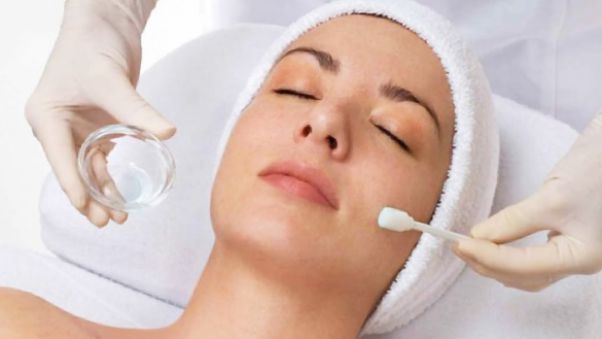
If you have been struggling with melasma on your skin, we have good news for you. There is a treatment for melasma that works, and we’ll tell you all about it.
It is probably no longer news that an increasing number of people are living with melasma today. While many of these cases are due to increasing ultraviolet rays from the sun, there are other contributing factors. But, one thing is certain — irrespective of the cause of your melasma, it does not have to stay with you forever.
Truthfully, melasma can be rather tough to get rid of, especially if you’re not receiving proper treatment. Moreover, the skin condition may be chronic in some people, which means it may recur after treating it. All these and several other reasons can make melasma frustrating for anyone living with it. But, it does not have to be.
Thanks to advancements in medical technology, several treatments now exist for melasma. However, not all these treatments show positive results across-board. But, there is one that stands out among the many options available — chemical peels. Indeed, if the statistics are any indication, chemical peels may just be the best treatment for melasma in Maple.
You’re probably already wondering about what this treatment is and how it works. We understand your curiosity, and we’ll ensure that you get answers.
This article explores various melasma facts, including what it is and why it occurs on the skin. More importantly, we share insights into how to treat melasma and highlight some treatments you can try. To top it off, you will discover what we firmly believe is the most effective treatment for melasma. Read further to find out more about melasma and its treatment.

What is Melasma?
In case you want to confirm if you indeed have melasma or you’re doing the research for a loved one, here are the basics. Melasma is a widespread skin condition that occurs as brown or gray pigmentations on the skin.
More often than not, melasma appears on the face, but recent studies have shown that other areas are also at risk. Here are some of the more common sites for melasma.
On the face, we have the:
- Forehead
- Nose bridge
- Upper lip
- Chin
- Cheeks
On other parts of the body:
- The neck
- The shoulders
- The forearms
Typically, melasma occurs due to the malfunctioning of the body’s melanocytes (its colour-making cells). Several conditions can cause this, and we’ll explore them later.
But when these conditions are in effect, the melanocytes start over-producing brown pigments in the affected area. Also, melasma may manifest in different colours, including tan, brown and grayish-brown blends.
More often than not, doctors can diagnose if you have melasma by only looking at your skin. Other times, they carry out a little biopsy to confirm. However, melasma does not rank as a medical emergency. But, due to the skin condition’s nature, it can cause undesirable mental and physical impacts on people who have. As such, it is usually a wise decision to seek effective treatment for melasma.
According to the experts, women are most at risk of developing the skin condition. Indeed, men make a shockingly low 10% of all melasma cases. There are several theories on why this is so, and we’ll shed some light on them later in this article.
Additionally, people that have darker skin are at a more significant risk of developing melasma. Experts believe that it is because they have more melanocytes than lighter-skinned people.
However, this is not to say that people with light skin are 100% immune to the condition. Thankfully, chemical peels as a treatment for melasma promise satisfactory results irrespective of your skin tone. By now, you should already have an in-depth understanding of what melasma is. But before we examine how to treat and get rid of melasma, let us show you some of the causes of the condition.
What Are The Causes Of Melasma?
Although research into the incidence of melasma is still ongoing, there are already some reasonably conclusive theories. In the next few paragraphs, you will gain insight into some of the causes of melasma as a skin condition.
Ultraviolet rays from the sun
Overexposure to the sun is one of the most common triggers for melasma in both men and women. This is because UV sun rays can influence the actions of melanocytes (pigment-controlling cells).
Melanocytes are more particularly active in people with darker skin tones, which makes them more susceptible. However, UV rays can also affect lighter-toned people.
Unfortunately, you don’t have to spend extended periods in the sun to get melasma. Indeed, a duration as short as walking to your car in the parking lot is enough time for your skin to absorb ultraviolet sun rays.
When this happens, the melanocytes start producing an excess amount of pigment in the areas the sun affects. So, if you have sensitive skin, it is an excellent idea to arm yourself with sunscreen at all times.
Pregnancy
Hormonal changes during pregnancy is another cause of melasma. It is also one of the reasons why the skin condition is more common among women. If you’ve had a loved one that went through pregnancy, you may have noticed a slight darkening on their faces during the time. That right there was melasma as a result of the hormonal changes in their body.
Melasma due to pregnancy may be even more intense if the woman is pregnant during the summer (more sunlight). Fortunately, the skin condition is rarely permanent if pregnancy hormones are the cause.
In other words, if you get melasma while pregnant, it is likely to clear on its own upon delivery. However, some other women may require special treatment for melasma to resolve it.

Oral Contraceptives
As a woman, if you take oral contraceptives, you may experience some degree of melasma. This is because of the changes the drug induces in your hormonal system to prevent the pregnancy. So, if you notice splotches of colour on your face when you use contraceptives, it is essential you consult your medical aesthetician.
While melasma is not dangerous, continuous use of the pill may cause the pigmentation to become permanent. That said, we also cannot advise you to discontinue the oral contraceptives. Therefore, if you fall into this category, you should consult with your doctor. You may need to commence treatment for melasma while keeping your contraceptives.
Hormone-replacement therapy (HRT)
With the way we discussed hormonal changes as a cause of melasma, you probably can already guess the problem with HRT. From the get-go, hormone-replacement therapy has always been a complicated and challenging journey. Here is one more challenge that comes with the procedure. It can cause intensive cases of melasma.
While you may not be able to stop your HRT, they may be more manageable ways to continue it without worsening your melasma. For instance, it may be better to take your HRT in the evenings instead of the mornings. This way, the sun will have fewer chances of reacting with the drug, thereby causing melasma. You can also ask your doctor if HRT patches and creams are an option.
These are typically less likely to cause or worsen melasma. Oral HRT drugs, on the other, go through the liver, which may convert them to melasma-causing compounds. However, if you have to use oral medicine, we recommend keeping your doses to the minimum possible.
Genetics
Finally, your genes may also be responsible for you experiencing cases of melasma. Although research is still ongoing to understand how genetics impacts melasma, surveys have proven something.
People with close relatives who have experienced melasma have a higher chance of developing the conditions themselves. In this case, there may be nothing you can do to prevent its occurrence. On the bright side, there is one effective treatment for melasma you can try.
Now that you know the various causes of widespread cases of melasma, let us explore how to treat it. Melasma does not have to be permanent, and in the next section, you will discover how you can get rid of it.
Related article: The Benefits of Chemical Peels
How to Treat Melasma: Effective Options for You
When it comes to treating melasma, there are several options out there. However, not all these treatment options offer the same level of satisfaction in terms of results.
Indeed, if you’re looking for effective melasma treatment in Maple, we recommend trying chemical peels. This procedure has one of the highest, if not the highest, success rates in terms of cleared melasma. That said, here are some common treatments you may try:
Use sunscreen
Since ultraviolet rays are one of the more common causes of melasma, we are confident you can use why using sunscreen is crucial.
However, the truth is using sunscreen cannot help you eradicate melasma if you already have it. But, it can help you prevent the condition from worsening. Therefore, sunscreen is one of your best friends in the battle against melasma.
Moreover, the success of an effective treatment for melasma hinges on you avoiding UV rays on your skin. You see, UV rays worsen Melasma spots. Therefore, if you cannot avoid the midday sun, use sunscreens with SPF ratings of at least 30. Apply the sunscreen before you go out and multiple times during the day, if you need to.
You can also wear wide-brimmed hats to keep sunlight off your face. If you have melasma in other areas of your body, you should wear shirts with long sleeves.
Hydroquinone
More often than not, doctors will first prescribe hydroquinone for a patient who has melasma. Hydroquinone is a topical chemical substance that serves to lighten the colour of the splotches of melasma on your skin.
It exists as either gel, lotion or cream. Your doctor may prescribe any depending on the extent of your skin condition, your daily routine and several other factors.
If you have a hydroquinone prescription, all you have to do is apply the product to your skin’s discoloured patches. However, a drawback with this form of treatment for melasma is that it usually takes extended periods before seeing results. This is because the active ingredients of hydroquinone don’t directly make your skin lighter.
Instead, the cream (or gel or lotion) acts on your melanocytes and causes them to stop producing darkening pigments. You only begin to see a difference when the supply of colour to the melasma splotches sufficiently reduces.
Corticosteroids and Tretinoin
Corticosteroids and Tretinoin are other options for the treatment for melasma that have shown some promising results. They are topical medications that have similar functions as hydroquinone. They also come with the possibilities of cream, gel or lotion.
In other words, Corticosteroids and Tretinoin function by lightening the colour of the melasma sites. However, like hydroquinone, these substances also have the disadvantage of lengthened waiting times.
Triple Creams
These are simply combination creams that contain all three substances in one – hydroquinone, Corticosteroids and Tretinoin. Depending on the extent of your skin condition, your dermatologist may prescribe a triple cream as a treatment for melasma.
Chemical Peels
Unlike the other treatment options, chemical peels for melasma have a higher success rate. In this case, the medical aesthetician will use light acids to remove a few layers of dead skin on your face. However, these are not random areas. Your provider will target and take off the areas of your skin with melasma. This allows newer skin (without melasma splotches) to grow in its place.
Essentially, chemical peels help you achieve a spotless, melasma-free complexion right under your skin. Indeed, chemical peels results have proven that it is arguable the fastest, safest and more effective way to treat melasma. The acids remove dead skin cells and trigger the formation of the replacements in minutes! Moreover, the treatment works for all skin types, irrespective of the intensity of the melasma patches.
You see, chemical peels come in different forms and strengths. So, your medical aesthetician only has to pick the perfectly suited product for your skin tone and layer. After this, all that is left is the procedure itself, and you can say goodbye to those ugly melasma spots. Indeed, if you’re looking for the best treatment for melasma, you may not need to look any further.
What to Expect During Chemical Peels Treatment
Understandably, your mind has probably started forming various questions about this innovative treatment. Well, the procedure itself is a relatively straightforward one. Here is a breakdown of what to expect from chemical peels as a treatment option.
- Your treatment appointment will start with your provider cleaning your skin. This is to remove excess oil and some particles of dead skin cells.
- Then, they will apply the chemical peeling agent (there are various options available).
- Once the application is over, the peeling agent will stay on your face for several minutes. The exact duration will depend on the peel ingredients, your skin type and the extent of your melasma.
- While the peel is on your skin, you may experience a slight burning or tingling sensation. This is perfectly normal and means that the peeling acid is working.
- Finally, your provider will remove the peel, alongside the skin with melasma splotches on them.
- Your skin may be red and tender after the chemical peel. This indicates a successful removal of your melasma-ridden epidermis.
Why Chemical Peels Are the Best Treatment for Melasma
Now that you know what to expect from chemical peels, let us examine why they are the best option for you.
Here are some of the reasons you should choose chemical peel treatments for Melasma in Maple today:
Chemical peels offer you better skin
You see, chemical peels as a treatment for melasma do not only eliminate the darker pigmentation on your skin. It does a thorough ‘deep-cleaning’. In other words, you get newer and younger-looking skin.
You see when the chemical peels remove the dead upper layer of skin, your body signals to younger cells beneath to replace them. So, you get radiant, and most importantly, melasma-free skin.
Chemicals peels are safe
Another advantage of using chemical peels for melasma is that you’re exposing yourself to fewer risks. Unlike some other options, there is a considerably lower chance of adverse reactions with chemical peels.
Moreover, your doctor can formulate the ingredients of your peel according to your specific needs and peculiarities. This means that even if you have sensitive skin, there is a safe and effective composition for you!
Chemical peels effectively control melasma
If your melasma results from hormonal changes, a permanent cure may be impossible if the hormone-influencing variable remains. But, using chemical peels alongside efficient sunscreen may be your best chance of staying ahead of the pigmentation.
On the other hand, chemical peels can be a permanent solution to melasma if the sun is the culprit. Of course, you’d have to avoid the sun diligently after the procedure.
Chemical peels can eliminate acne and dark circles
This is merely a bonus point. If you are struggling with acne or dark circles under the eyes, chemical peels can also help you. Depending on the peel’s composition, they can unclog skin pores and remove blackheads. Moreover, the treatment can also target the irritations that cause dark circles in people with sensitive skin.
In Conclusion
Today, an increasing number of people are developing cases of melasma. Experts believe most of this is because more UV rays are reaching the earth than ever before. Well, they may be right. But, the fact is you don’t have to live with pigmentation on your face. Chemical peels are a treatment for melasma that has helped many achieve perfect complexions.
Indeed, while melasma is medically harmless, we understand how bothersome it can be. Thankfully, you can also enjoy the clear skin results of chemical peels as they are only one action away.
All you have to do is book yourself an appointment for an effective melasma treatment at our medical spa in Maple today. Contact Canada MedLaser to speak with an expert today.
Book Free Consultation
"*" indicates required fields
-
Facebook
-
Twitter
-
Linkedin





